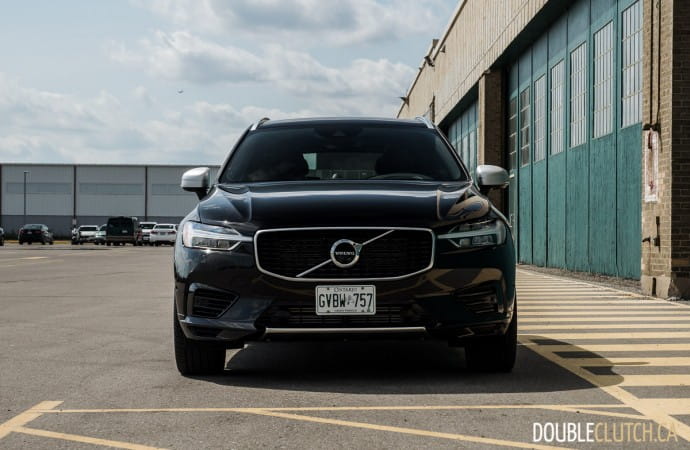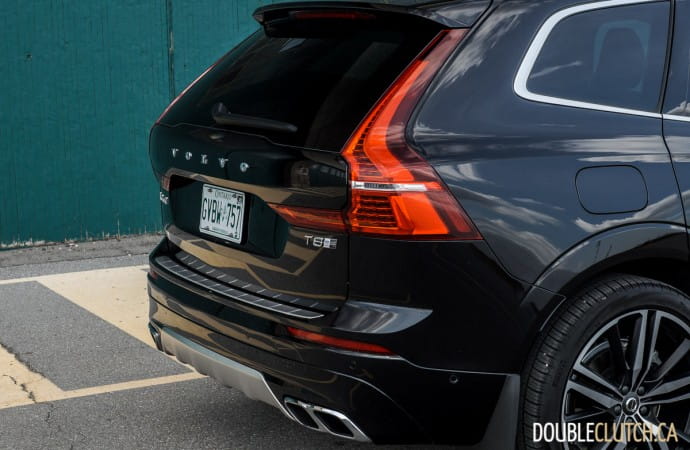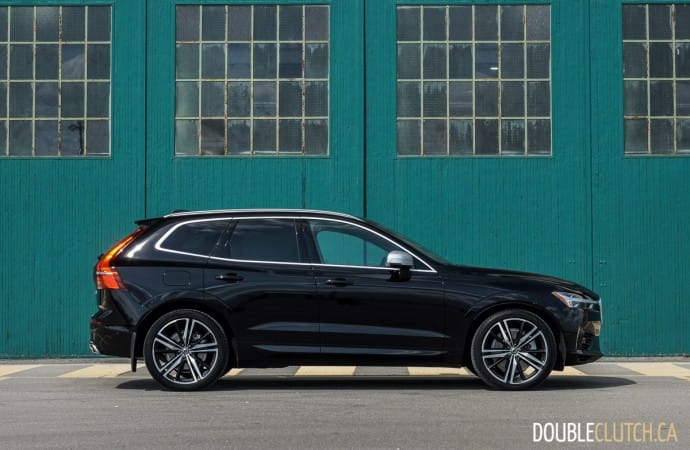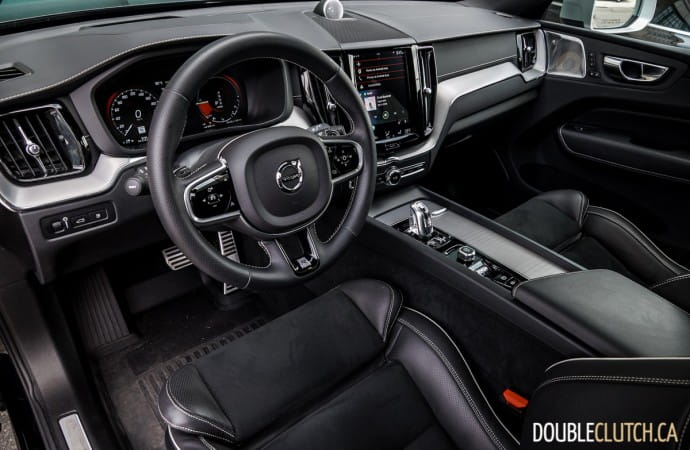As more and more automakers adopt electrification across their various product lines, Volvo is among the ones leading the charge, committing to some form of electric power for every new vehicle launched moving forward. Some of these may constitute “mild” hybrid systems that take advantage of kinetic energy recovery, but the more important bit is that plug-in hybrid options will be available on every model starting this year. At the further end of their goalpost, they are targeting half of all sales to be fully electric by 2025. To check out where they stand today, we got our hands on a 2020 Volvo XC60 T8 R-Design plug-in hybrid for some short and long distance driving evaluation.

In general, the premise of a plug-in hybrid electric vehicle (PHEV) is the opportunity to utilize two different systems to power the car. On paper, they purport to offer the best of both worlds – a nominal amount of electric range to handle most city commuting, combined with an internal combustion engine to take over for longer drives. Drivers can either be religious about plugging in whenever they can, but they can also not give a damn and drive it like a conventional hybrid that works only on regenerative braking to charge the battery. Another key point with a PHEV is “green vehicle” eligibility, which means unfettered carpool lane access even with a single occupant, as well as possible government incentives when purchasing new.
As with all other “T8” engine Volvos, it doesn’t mean that there are eight cylinders under the hood, but instead this signifies a twin engine, twin-charged setup. There’s a 2.0-litre inline four-cylinder gasoline engine that’s turbocharged and supercharged, coupled to an electric motor that assists with motive power. The gas unit is still the lead amongst the two, and puts out almost the same as the T6 twin-charged models: peak fossil fuel output is 313 horsepower at 6,000RPM and 295 lb-ft. of torque between 2,200 and 5,400RPM. The electric motor is good for 87 horsepower at 7,000RPM, and also 177 lb-ft. of torque between zero and 3,000RPM.

Combined system output is rated at an equivalent 400 horsepower and 472 lb-ft. of torque, and Volvo says that the zero to 100KM/H sprint happens in 5.5 seconds – about about 0.4 seconds faster than an ordinary T6 model. Battery capacity is 11.4 kilowatt-hours (kWh), which brings with it a rated range of 27 kilometres. Electric versus gasoline driving modes are selectable in a few different ways – standard hybrid, “Pure” full electric, a “Hold” function for gas only, and a high-output performance mode.
For best results, full electric function is best enjoyed in a city driving setting, so drivers may want to use the Pure mode in stop and go traffic. When doing so, the gauge cluster reports a range of 32 kilometres on a full charge, and with regenerative braking able to charge the battery, drivers may report beating the 32 kilometre rating. As with all electric vehicles, range can be diminished with heating and air conditioning use. For what it’s worth, heated seats and steering wheel are a little more efficient to use when the weather isn’t too chilly. On the open highway, it can take a lot of battery capacity to accelerate and climb hills, and so using the Hold function can save battery capacity for later use.

When using gasoline only, nominal fuel economy ratings come in a 9.5L/100KM in the city, and 8.5L/100KM on the highway – as compared to a regular T6 model that gets 11.7L/100KM and 8.6L/100KM, respectively. Depending on the length of drivers’ daily commutes, these numbers can fluctuate wildly between zero and the nominal numbers, or worse. When used as directed, expect great range on a single tank, and with enough electric in the mix, over 1,000 kilometres can be had between fillups, though premium fuel is required. Observed consumption over two weeks of testing netted about 5.5L/100KM with plenty of out-of-town road trips on the highway, where charging wasn’t really a possibility.
Other than the plug-in hybrid electric powertrain, the XC60 T8 R-Design is a snazzy looking vehicle, with sporty accents (silver painted mirrors, unique grille) making this trim level the best looking one of the bunch. A sport-tuned suspension and optional four-corner air suspension make it a competent handler as well, with flat cornering and impressive grip levels out of the 255 section width tires. Ride quality is on the firm side, as is typical with European cars, but body control is excellent, and cruising at speed is still smooth as glass.

On the inside, the XC60 has a fantastically designed interior, and even after a few years of this design language on the market, Volvo is still second-to-none in this business. While the materials and touch points aren’t quite as nice as the upmarket XC90 sport utility or S90 sedan, the bones are all there, and the midsized Volvo is a great place to spend time. Seats are comfortable for long trims and are adjustable just the way you like it, and the devil can be seen in every detail. To show that they mean business, Volvo has even outfitted an Orrefors Crystal shift knob on all T8 PHEV models! On the flips ide, unfortunately, electrification does mean the sacrifice of a few features, namely rear climate control and glovebox refrigeration.
As can be expected for a vehicle in a crossover sport utility format, interior space and cargo are strong suits on the Volvo XC60. Cargo volume is reasonable behind the second row, but runs a little short on length. Rated capacity comes in at 598 litres (21.1 cubic feet) with the second row left up, and grows to 1,395 litres (49.2 cubic feet) with the seats folded flat. Depending on how tall your cargo is, a midsize sedan is likely to accommodate more length.

For infotainment, the Sensus system on the XC60 T8 features a nine-inch central touch screen, and might be the only source of gripes on an otherwise great car. With only a few buttons and knobs for volume control, track skip, and climate control defrost functions, everything else requires touch inputs. While this makes it a slick interface in general, it does require more driver distraction and eyes off the road to operate, which isn’t too helpful at all.
The system isn’t the quickest to start up, and there’s noticeable lag on inputs for the first minute or two. Thankfully, both Android Auto and Apple CarPlay integration are standard equipment, so the clunky interface can be somewhat hidden with the latest in smartphone connectivity systems, their associated voice commands, and more intuitive interfaces. In terms of audio systems, the optional Bowers & Wilkins setup is one of the best in the business, with amazing clarity and clean bass through an 11-speaker, 1,100-watt design.

While a base XC60 starts at $46,800 for a turbocharged-only T5 turbo four, the T6 R-Design starts at $57,450. This number further balloons to $71,850 for the PHEV T8, and it’s also pretty hard not to check off many of the option boxes available. The test car came with $900 Onyx Black Metallic paint (there aren’t any free colours in R-Design, frustratingly enough), $1,475 21-inch five-triple spoke wheels, a $1,500 tailored dashboard with colour-contrast stitching, $1,900 Convenience Package (power folding rear seats, Pilot Assist semi-autonomous driver assistance), $1,250 Climate Package (heated steering wheel, rear seats, and wiper blades), $1,800 Vision Package (Park Assist, 360-degree camera, auto dimming mirrors, blind spot monitoring system), $3,750 Bowers & Wilkins audio, $2,350 four-corner air suspension, and a $1,500 heads-up display. This brought the total as-tested price to $85,875.
Considered in absolute terms, the 2020 Volvo XC60 T8 R-Design is an excellent premium small-to-medium crossover sport utility that’s fun to drive, saves money on fueling costs, and is very easy on the eyes to boot. The plug-in hybrid powertrain is a delight, but the 32 kilometres of range (or less) mean that there is a bit more reliance on gasoline than would be ideal. That said, don’t count on competitors to do any better here. For now, BMW doesn’t offer an X3 plug-in hybrid, and the XC60 compares well against a Mercedes-Benz GLC 350e 4MATIC PHEV. Where the discussion can change is the price: at over eighty-five grand before rebates, the T8 is nearly thirteen large extra over a gas-only T6. With Natural Resources Canada estimating that the average driver saving just over $800 annually between each powertrain, it might take a good while to recoup the extra cost, and other factors such as carbon footprint and green vehicle perks should be in the equation in order to justify the T8.
See Also:
2018 Volvo XC60 T6 R-Design
2019 Jaguar F-Pace S
2019 Lexus NX 300 F-Sport AWD

